


A hot-water bottle is a bottle filled with hot water and sealed with a stopper, used to provide warmth, typically while in bed, but also for the application of heat to a specific part of the body.



A hot-water bottle is a bottle filled with hot water and sealed with a stopper, used to provide warmth, typically while in bed, but also for the application of heat to a specific part of the body.

Containers for warmth in bed were in use as early as the 16th century. The earliest versions contained hot coals from the dying embers of the fire, and these bed warmers were used to warm the bed before getting into it.
Containers using hot water were soon also used, with the advantages that they could remain in the bed with the sleeper and were not so hot as to be a fire risk.
Prior to the invention of rubber that could withstand sufficient heat, these early hot-water bottles were made of a variety of materials, such as zinc, copper, [1] brass, [2] glass, [3] earthenware [4] [3] [5] or wood. To prevent burning, the metal hot water flasks were wrapped in a soft cloth bag.
"India rubber" hot-water bottles were in use in Britain at least by 1875. [6] Modern conventional hot-water bottles were patented in 1903 and are manufactured in natural rubber or PVC, to a design patented by the Croatian inventor Slavoljub Eduard Penkala. They are now commonly covered in fabric, sometimes with a novelty design.

Some newer products function like the older bottles, but use a polymer gel or wax in a heating pad. The pads can be heated in a microwave oven, and they are marketed as safer than liquid-filled bottles or electrically heated devices. Some newer bottles now use a silicone-based material instead of rubber, which resists very hot water better, and does not deteriorate as much as rubber. Although the stopper size in Ireland and the UK has been largely standard for many decades, some newer bottles use a wider mouth which is easier to fill (and a larger stopper to fit it).

While generally used for keeping warm, conventional hot-water bottles can be used to some effect for the local application of heat as a medical treatment, for example for period pain relief, [7] [8] [9] but newer items such as purpose-designed heating pads are often used now.
The United Kingdom defined British Standards for hot-water bottles to regulate their manufacture and sale as well as to ensure their compliance with all safety standards. The British Standards BS 1970 and BS 1970:2012 (updated version) define, for instance, the bottles’ filling characteristics, safety instructions, allowed materials and components as well as testing methods such as tensile tests for PVC bottles. [10]
Most regulations applied to a country are generally harmonized in order to be applied and applicable in a larger area, such as a trade zone.
There have been problems with premature failure of rubber hot-water bottles due to faulty manufacture. [11] The rubber may fail strength or fitness tests, or become brittle if manufacturing is not controlled closely. Natural rubber filled with calcium carbonate is the most common material used, but is susceptible to oxidation and polymer degradation at the high temperatures used in shaping the product. Even though the brittle cracks may not be visible externally, the bottle can fracture suddenly after filling with hot water, and can scald the user—sometimes requiring hospitalization for severe burn cases. [12] [13]
Boiling water is not recommended for use in hot-water bottles. This is due to risks of the rubber being degraded from high-temperature water, and the risk of injury in case of breakage. [14]
Hot water bottle rash (Erythema ab igne) is a skin condition caused by long-term exposure to heat (infrared radiation) or excessive use of a hot water bottle.

A test tube, also known as a culture tube or sample tube, is a common piece of laboratory glassware consisting of a finger-like length of glass or clear plastic tubing, open at the top and closed at the bottom.

A thermoplastic, or thermosoftening plastic, is any plastic polymer material that becomes pliable or moldable at a certain elevated temperature and solidifies upon cooling.
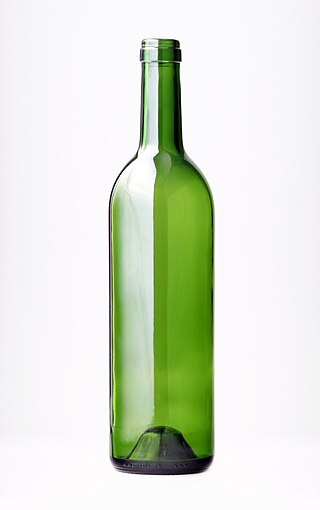
A bottle is a narrow-necked container made of an impermeable material in various shapes and sizes that stores and transports liquids. Its mouth, at the bottling line, can be sealed with an internal stopper, an external bottle cap, a closure, or induction sealing.
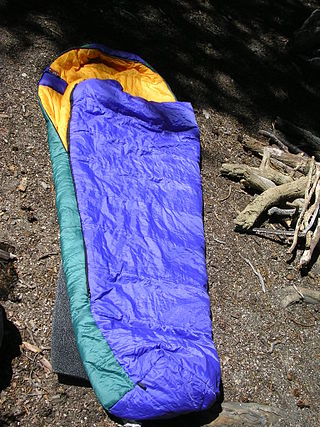
A sleeping bag is an insulated covering for a person, essentially a lightweight quilt that can be closed with a zipper or similar means to form a tube, which functions as lightweight, portable bedding in situations where a person is sleeping outdoors. It is also commonly used indoors for people who do not have beds or at sleepovers. Its primary purpose is to provide warmth and thermal insulation through its synthetic or down insulation. It also typically has a water-resistant or water-repellent cover that protects, to some extent, against wind chill and light precipitation, but a tent is usually used in addition to a sleeping bag, as it performs those functions better. The bottom surface also provides some cushioning, but a sleeping pad or camp cot is usually used in addition to that purpose. The bottom surface of a sleeping bag may be moderately water repellent, but a plastic tarp or groundsheet is often used to protect against moist ground.
A waterbed, water mattress, or flotation mattress is a bed or mattress filled with water. Waterbeds intended for medical therapies appear in various reports through the 19th century. The modern version, invented in San Francisco and patented in 1971, became a popular consumer item in the United States through the 1980s with up to 20% of the market in 1986 and 22% in 1987. By 2013, they accounted for less than 5% of new bed sales.

An air mattress is an inflatable mattress or sleeping pad.

A water dispenser, known as water cooler, is a machine that dispenses and often also cools or heats up water with a refrigeration unit. It is commonly located near the restroom due to closer access to plumbing. A drain line is also provided from the water cooler into the sewer system.
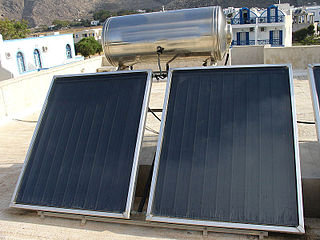
A solar thermal collector collects heat by absorbing sunlight. The term "solar collector" commonly refers to a device for solar hot water heating, but may refer to large power generating installations such as solar parabolic troughs and solar towers or non water heating devices such as solar cooker, solar air heaters.

A mattress is a large, usually rectangular pad for supporting a lying person. It is designed to be used as a bed, or on a bed frame as part of a bed. Mattresses may consist of a quilted or similarly fastened case, usually of heavy cloth, containing materials such as hair, straw, cotton, foam rubber, or a framework of metal springs. Mattresses may also be filled with air or water.

Plastic welding is welding for semi-finished plastic materials, and is described in ISO 472 as a process of uniting softened surfaces of materials, generally with the aid of heat. Welding of thermoplastics is accomplished in three sequential stages, namely surface preparation, application of heat and pressure, and cooling. Numerous welding methods have been developed for the joining of semi-finished plastic materials. Based on the mechanism of heat generation at the welding interface, welding methods for thermoplastics can be classified as external and internal heating methods, as shown in Fig 1.
A heating pad is a pad used for warming of parts of the body in order to manage pain. Localized application of heat causes the blood vessels in that area to dilate, enhancing perfusion to the targeted tissue. Types of heating pads include electrical, chemical and hot water bottles.

A flat roof is a roof which is almost level in contrast to the many types of sloped roofs. The slope of a roof is properly known as its pitch and flat roofs have up to approximately 10°. Flat roofs are an ancient form mostly used in arid climates and allow the roof space to be used as a living space or a living roof. Flat roofs, or "low-slope" roofs, are also commonly found on commercial buildings throughout the world. The U.S.-based National Roofing Contractors Association defines a low-slope roof as having a slope of 3 in 12 (1:4) or less.

A heat sealer is a machine used to seal products, packaging, and other thermoplastic materials using heat. This can be with uniform thermoplastic monolayers or with materials having several layers, at least one being thermoplastic. Heat sealing can join two similar materials together or can join dissimilar materials, one of which has a thermoplastic layer.
Cross-linked polyethylene, commonly abbreviated PEX, XPE or XLPE, is a form of polyethylene with cross-links. It is used predominantly in building services pipework systems, hydronic radiant heating and cooling systems, domestic water piping, insulation for high tension electrical cables, and baby play mats. It is also used for natural gas and offshore oil applications, chemical transportation, and transportation of sewage and slurries. PEX is an alternative to polyvinyl chloride (PVC), chlorinated polyvinyl chloride (CPVC) or copper tubing for use as residential water pipes.
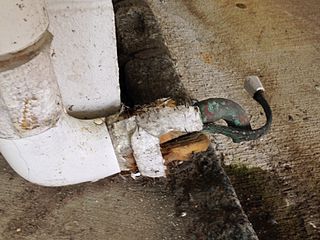
Electric heat tracing, heat tape or surface heating, is a system used to maintain or raise the temperature of pipes and vessels using heat tracing cables. Trace heating takes the form of an electrical heating element run in physical contact along the length of a pipe. The pipe is usually covered with thermal insulation to retain heat losses from the pipe. Heat generated by the element then maintains the temperature of the pipe. Trace heating may be used to protect pipes from freezing, to maintain a constant flow temperature in hot water systems, or to maintain process temperatures for piping that must transport substances that solidify at ambient temperatures. Electric trace heating cables are an alternative to steam trace heating where steam is unavailable or unwanted.

Hand warmers are small, often disposable, packets that produce heat to warm cold hands. They are used throughout the world in a variety of ways, including outdoor recreation, manual labor, and homelessness.
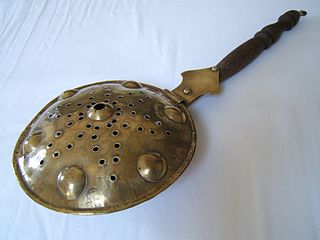
A bed warmer or warming pan was a common household item in countries with cold winters, especially in Europe. It consisted of a metal container, usually fitted with a handle and shaped somewhat like a modern frying pan, with a solid or finely perforated lid. The pan would be filled with embers and placed under the covers of a bed, to warm it up or dry it out before use.

An electric blanket is a blanket that contains integrated electrical heating wires. Types include underblankets, overblankets, throws, and duvets. An electric underblanket is placed above the mattress and below the bottom bed sheet. This is the most common type in the UK and Commonwealth countries, where it is known by default as an "electric blanket"; in the U.S. and Canada, where it is less common, it is called an electric heated mattress pad. An electric overblanket is placed above the top bed sheet, and is the most common type in the U.S. and Canada, where it is called an "electric blanket".

A mattress pad, mattress topper, or underpad is designed to lie atop a mattress. Made from a variety of materials including wool, cotton, memory foam, feather and latex, its function is to provide an extra layer of comfort, especially when the existing mattress is worn or uncomfortable.

BOD Bottle or an incubation bottle is a main apparatus used for the Biological Oxygen Demand (BOD) test. During the five-day BOD or BOD5 test process, the BOD bottle is used for incubating diluted samples under the 20 °C or 68 °F of temperature.